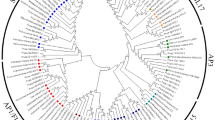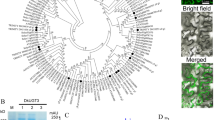Abstract
The ubiquitin-mediated proteolysis via Arg N-degron branch regulates various plant developmental processes and responds to multiple stresses. Nevertheless, limited information is available on the significance of the pathway during fruit ripening. This study reports that the suppression of PROTEOLYSIS6 (PRT6) E3 ligase in tomato through RNAi altered the gene expression of four Ethylene Response Factors (ERFs) (SIERF77, SIERF2, JERF1, and JERF3). The transient expression of 35S::PRT6_RNAi and PG::PRT6_RNAi constructs successfully down-regulated the PRT6 expression in leaves and mature green fruits through 35S promoter, and in breaker-stage fruits via polygalacturonase (PG) promoter, respectively. Reverse transcription-quantitative PCR (RT-qPCR) analysis showed an increased expression of SIERF77, SIERF2, and JERF1 but decreased JERF3 expression in the leaves and mature green fruits agroinfiltrated with 35S::PRT6_RNAi. Ripening-specific SIERF2 showed an increased expression in the breaker-stage fruits agroinfiltrated with PG::PRT6_RNAi, supporting the hypothesis that a low expression level of PRT6 affected the expression patterns of ERFs in specific tissues of tomato. Conversely, the expression of pectin methylesterase (PME) decreased in the breaker fruits. The four orthologues of tomato ERFs had been found to be the Arg N-degron substrates in Arabidopsis, with physiological functions being regulated at the protein level. This study showed that the suppression of PRT6 influenced the expression of these four transcription factors and PME.





Similar content being viewed by others
Abbreviations
- RT-qPCR:
-
Reverse transcription-quantitative PCR
- GUS:
-
β-Glucuronidase
- ABA:
-
Abscisic acid
References
Abbas M, Berckhan S, Rooney DJ, Gibbs DJ, Conde JV, Correia CS, Bassel GW, Marin-de la Rosa N, Leon J, Alabadi D, Blazquez MA, Holdsworth MJ (2015) Oxygen sensing coordinates photomorphogenesis to facilitate seedling survival. Curr Biol 25:1483–1488
Alexander L, Grierson D (2002) Ethylene biosynthesis and action in tomato: a model for climacteric fruit ripening. J Exp Bot 53:2039–2055
Cara B, Giovannoni JJ (2008) Molecular biology of ethylene during tomato fruit development and maturation. Plant Sci 175:106–113
Chapman NH, Bonnet J, Grivet L, Lynn J, Graham N, Smith R, Sun G, Walley PG, Poole M, Causse M, King GJ, Baxter C, Seymour GB (2012) High resolution mapping of a fruit firmness-related QTL in tomato reveals epistatic interactions associated with a complex combinatorial locus. Plant Physiol 159:1644–1657
Gao J, Zhang Y, Li Z, Liu M (2020) Role of Ethylene Response Factors (ERFs) in fruit ripening. Food Qual Saf 4:15–20
Gibbs DJ, Lee SC, Isa NM, Gramuglia S, Fukao T, Bassel GW, Correia CS, Corbineau F, Theodoulou FL, Bailey-Serres J, Holdsworth MJ (2011) Homeostatic response to hypoxia is regulated by the N-end rule pathway in plants. Nature 479:415–418
Gibbs DJ, Isa NM, Movahedi M, Lozano-Juste J, Mendiondo GM, Berckhan S, Marin-de la Rosa N, Conde JV, Correia CS, Pearce SP, Bassel GW, Hamali B, Talloji P, Tome D, Coego A, Beynon J, Alabadi D, Bachmair A, León J, Gray JE, Theodoulou FL, Holdsworth MJ (2014) Nitric oxide sensing in plants is mediated by proteolytic control of group vii erf transcription factors. Mol Cell 53:369–379
Holdsworth MJ, Vicente J, Sharma G, Abbas M, Zubrycka A (2019) The plant N-degron pathways of ubiquitin mediated proteolysis. J Integr Plant Biol 62(1):70–89
Holman TJ, Jones PD, Russell L, Medhurst A, Tomas SU, Talloji P, Marquez J, Schmuths H, Tung SA, Taylor I, Footitt S, Bachmair A, Theodoulou FL, Holdsworth MJ (2009) The N end rule pathway promotes seed germination and establishment through removal of ABA sensitivity in Arabidopsis. Proc Natl Acad Sci USA 106:4549–4554
Hoshikawa K, Fujita S, Renhu N, Ezura K, Yamamoto T, Nonaka S, Ezura H, Miura K (2018) Efficient transient protein expression in tomato cultivars and wild species using agroinfiltration- mediated high expression system. Plant Cell Rep 38:75–84
Lee JM, Joung J-G, McQuinn R, Chung M-Y, Fei Z, Tieman D, Klee H, Giovannoni J (2012) Combined transcriptome, genetic diversity and metabolite profiling in tomato fruit reveals that the ethylene response factor SIERF6 plays an important role in ripening and carotenoid accumulation. Plant J 70:191–204
Li Y, Zhu B, Xu W, Zhu H, Chen A, Xie Y, Shao Y, Luo Y (2007) LeERF1 positively modulated ethylene triple response on etiolated seedling, plant development and fruit ripening and softening in tomato. Plant Cell Rep 26:1999–2008
Licausi F, Kosmacz M, Weits DA, Giuntoli B, Giorgi FM, Voesenek LACJ, Perata P, van Dongen JT (2011) Oxygen sensing in plants is mediated by an N-end rule pathway for protein destabilization. Nature 479:419–422
Liu M, Gomes BL, Mila I, Purgatto E, Peres LEP, Frasse P, Maza E, Zouine M, Roustan J-L, Bouzayen M, Pirello J (2016) Comprehensive profiling of Ethylene Response Factor expression identifies ripening- associated ERF genes and their link to key regulators of fruit ripening in tomato. Plant Physiol 170:1732–1744
Mendiondo GM, Gibbs DJ, Szurman-Zubrzycka M, Korn A, Marquez J, Szarejko I, Maluszynski M, King J, Axcell B, Smart K, Corbineau F, Holdsworth MJ (2016) Enhanced waterlogging tolerance in barley by manipulation of expression of the N-end rule pathway E3 ligase PROTEOLYSIS6. Plant Biotech J 14:40–50
Orzaez D, Mirabel S, Wieland WH, Granell A (2006) Agroinjection of tomato fruits. A tool for rapid functional analysis of transgenes directly in fruit. Plant Physiol 140:3–11
Phan TD, Bo W, West G, Lycett GW, Tucker GA (2007) Silencing of the major salt-dependent isoform of pectinesterase in tomato alters fruit softening. Plant Physiol 144:1960–1967
Pirrello J, Jaimes-Miranda F, Sanchez-Ballesta MT, Tournier B, Khalil-Ahmad Q, Regad F, Latché A, Pech JC, Bouzayen M (2006) Sl-ERF2, a tomato ethylene response factor involved in ethylene response and seed germination. Plant Cell Physiol 47:1195–1205
Roslan N, Chew B, Goh H-H, Isa NM (2018) Sequence analysis of PROTEOLYSIS6 from Solanum Lycopersicum. Am Inst Phys 1940:1–6
Ross HA, Wright KM, McDougall GJ, Roberts AG, Chapman SN, Morris WL, Hancock RD, Stewart D, Tucker GA, James EK, Taylor MA (2011) Potato tuber pectin structure is influenced by pectin methyl esterase activity and impacts on cooked potato texture. J Exp Bot 62:371–381
Seymour GB, Chapman NH, Chew B, Rose JKC (2013) Regulation of ripening and opportunities for control in tomato and other fruits. Plant Biotechnol J 11:269–278
Suka IE (2018) The study of PRT6 RNAi transient expression using polygalacturonase promoter in micro tom (Solanum lycopersicum). Faculty of Science Technology, Universiti Kebangsaan Malaysia
Suka IE, Roslan NF, Chew B, Goh H-H, Zainal Z, Isa NM (2018) Agrobacterium tumefaciens mediated transformation of the proteolysis 6 (PRT6) gene into cotyledons of tomato cv. Micro tom. Sains Malaysiana 47(7):1465–1471
Varshavsky A (2011) The N-end rule pathway and regulation by proteolysis. Protein Sci 20:1298–1345
Varshavsky A (2019) N-degron and C-degron pathways of protein degradation. Proc Natl Acad Sci USA 116:358–366
Vicente J, Mendiondo GM, Pauwels J, Pastor V, Izquierdo Y, Naumann C, Movahedi M, Rooney D, Gibbs DJ, Smart K, Bachmair A, Gray JE, Dissmeyer N, Castresana C, Ray RV, Gevaert K, Holdsworth MJ (2019) Distinct branches of the N-end rule pathway modulate the plant immune response. New Phytol 221:988–1000
Wang H, Huang Z, Chen Q, Zhang Z, Zhang H, Wu Y, Huang D, Huang R (2004) Ectopic overexpression of tomato JERF3 in tobacco activates downstream gene expression and enhances salt tolerance. Plant Mol Biol 55:183–192
Xie X-L, Yin X-R, Chen K-S (2016) Roles of APETALA2/ethylene-response factors in regulation of fruit quality. Crit Rev Plant Sci 35:120–130
Yamamoto T, Hoshikawa K, Ezura K, Okazawa R, Fujita S, Takaoka M, Mason HS, Ezura H, Miura K (2018) Improvement of the transient expression system for production of recombinant proteins in plants. Sci Rep 8:4755
Zhang HT, Gannon L, Jones PD, Rundle CA, Hassall KL, Gibbs DJ, Holdsworth MJ, Theodoulou FL (2018) Genetic interactions between ABA signalling and the Arg/N-end rule pathway during Arabidopsis seedling establishment. Sci Rep 8:15192
Acknowledgements
This work was supported by the Ministry of Higher Education (MoHE) via Fundamental Research Grants Scheme (FRGS/2/2014/SG05/UKM/02/5) awarded to NMI. IES and NFR were partially funded through the MyBrain scheme under the Ministry of Higher Education (MoHE) for their Graduate program Fees.
Author information
Authors and Affiliations
Contributions
IES, NFR, BLC, H-HG, ZZ and NMI conceived and designed experiments. IES and NFR performed the experiments. IES, NFR, BLC, H-HG, and NMI analyzed the data. IES, NFR, BLC, H-HG, SSJ and NMI wrote, edit and proofread the manuscript.
Corresponding author
Ethics declarations
Conflict of interest
The authors declare that they have no conflict of interest.
Additional information
Publisher's Note
Springer Nature remains neutral with regard to jurisdictional claims in published maps and institutional affiliations.
Supplementary Information
Below is the link to the electronic supplementary material.
Rights and permissions
About this article
Cite this article
Suka, I.E., Roslan, N.F., Chew, B.L. et al. The effects of PROTEOLYSIS6 (PRT6) gene suppression on the expression patterns of tomato ethylene response factors. J. Plant Biochem. Biotechnol. 31, 115–123 (2022). https://doi.org/10.1007/s13562-021-00662-4
Received:
Accepted:
Published:
Issue Date:
DOI: https://doi.org/10.1007/s13562-021-00662-4




